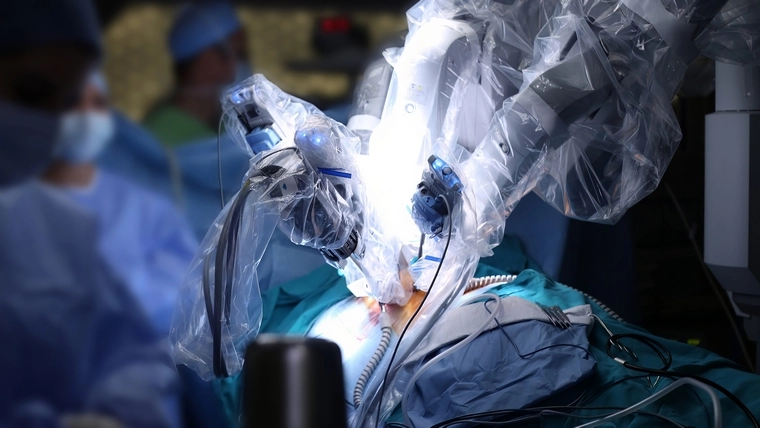
What is Robotic Cardiovascular Surgery and In Which Diseases is it Used?
Robotic cardiovascular surgery is a revolutionary technology in the treatment of cardiovascular diseases, representing the most advanced form of minimally invasive surgical methods. This technology allows surgeons to provide patients with more precise, safe and rapid treatment. In cardiovascular surgery, operations performed using robotic systems offer fewer complications and a faster recovery time than traditional open surgery. In this article, you will find detailed information about what robotic cardiovascular surgery is, its advantages, risks, which diseases it is used to treat, the recovery process and who can benefit from this treatment.
What is Robotic Cardiovascular Surgery?
Robotic Cardiovascular Surgery is a method of heart surgery performed through very small incisions in the chest. In this method, surgeons can perform heart surgeries much less invasively than traditional open-heart surgery using small surgical instruments and robotically controlled vehicles. This procedure is also known as da Vinci surgery, which is the name of the robot usually used. Robotic surgery has been applied to a variety of heart-related procedures, including heart valve surgeries, coronary artery bypass surgery, heart tissue ablation, heart defect repair, and tumor removal. This surgical method offers patients less pain, faster recovery time, and a lower risk of complications.
What are the advantages of robotic cardiovascular surgery?
The main advantages of robotic surgery in the cardiovascular field include a minimally invasive approach, fewer scars, a lower risk of infection, and a faster recovery time. Robotic systems offer the surgeon a freedom of movement and precision that cannot be achieved in traditional surgery, which allows for more successful surgical outcomes. In addition, the less traumatic procedure offered by robotic surgery allows patients to feel less pain after surgery and to return to their daily activities in a shorter period of time.
What are the risks of robotic cardiovascular surgery?
Robotic Cardiovascular Surgery stands out as a less invasive method compared to traditional open-heart surgery. Since this surgical method does not require the surgeon to open the ribcage and cut the breastbone (sternum), many complications associated with open-heart surgery are eliminated. For example, cutting the ribcage in open-heart surgery can lead to conditions such as long recovery times, infection risks, and more pain. In robotic surgery, these complications are significantly reduced. However, robotic surgery also has its own risks, and it is important to know these risks.
- Anesthesia-Related Complications: Since the surgical procedure must be performed under general anesthesia, anesthesia-related complications may occur.
- Surgical Risks: There are risks during surgery, such as heart attack, stroke, infection, and, rarely, death. These complications can vary depending on the patient's general health and the complexity of the surgery.
- Inability to Complete the Procedure: During robotic surgery, in rare cases, the surgeon may not be able to complete the procedure with the robotic system. In this case, conversion to open heart surgery may be required in order for the surgery to continue. This can prolong the surgical process and create additional risks.
- Existing Medical Conditions: A patient's existing medical condition may affect the risk profile of robotic surgery. Factors such as previous heart conditions, diabetes, kidney disease, or obesity may increase surgical risks.
Therefore, it is extremely important for patients to have a thorough conversation with their doctor about all potential risks and benefits prior to surgery. This discussion will help patients make an informed decision and ensure that the surgical process is managed as safely as possible.
What Diseases Are Used in the Treatment of Robotic Cardiovascular Surgery?
Robotic cardiovascular surgery is used in the treatment of various cardiovascular diseases. This method is widely used in the treatment of coronary artery disease, heart valve diseases, atrial fibrillation and some congenital heart diseases. The precision and minimally invasive nature provided by robotic surgery provides great advantages in such complex surgical procedures.
Recovery Process After Robotic Cardiovascular Surgery
The recovery process after robotic cardiovascular surgery is usually faster and more comfortable than traditional open surgery. Patients experience less pain after surgery and have shorter hospital stays. During this process, it is important for patients to follow their doctor's recommendations, keep the surgical area clean, and follow a set follow-up schedule. Full recovery usually occurs within a few weeks, but this period can vary from patient to patient.
Who Can Receive Robotic Cardiovascular Treatment?
To determine if you are a candidate for Robotic Cardiovascular Surgery, your doctor will review your medical history, lifestyle, and overall severity of your disease. You will also be asked to sign a consent form stating that you consent to the procedure. It is important to read the form carefully and ask questions about anything you do not understand.
Before the procedure, your doctor may review your medical history and perform a physical exam to assess your overall health. This exam helps determine if you are in good general health for surgery. Blood tests and other diagnostic tests may also be performed. In some cases, your doctor may recommend that you take aspirin before the procedure.
If you are pregnant or think you may be pregnant, be sure to tell your doctor. It is also important to let your doctor know if you have any sensitivities or allergies to any medications, latex, iodine, bandages, contrast media, or anesthetic agents (local or general).
Tell your doctor about all prescription and nonprescription medications and herbal supplements you are taking. If you have a history of bleeding disorders or are taking blood thinners, aspirin, or other medications that affect blood clotting, you may need to stop these medications before the procedure. Also, tell your doctor if you have a pacemaker or other implanted heart device.
If you smoke, it is recommended that you quit smoking as soon as possible before surgery. This will improve your chances of a successful recovery from surgery and your overall health. You will be asked to refrain from eating, drinking, or taking any oral medications for 8 hours before surgery, usually after midnight.
Depending on your medical condition, your doctor may also recommend other special preparations. These processes are critical in determining whether you are a good candidate for robotic cardiovascular surgery.
.webp?lang=tr-TR&ext=.webp)
